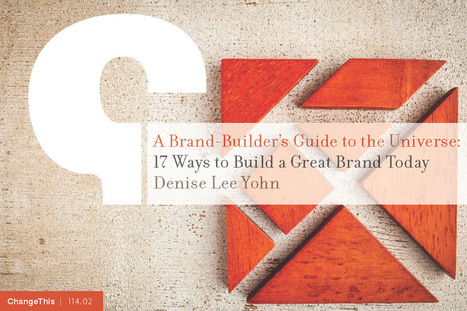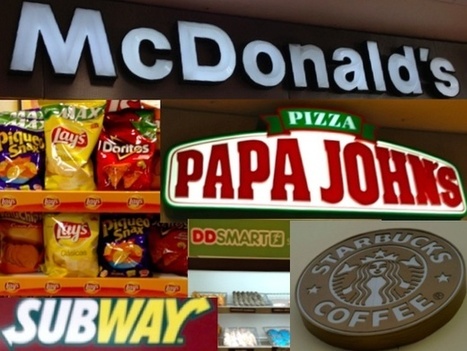 Your new post is loading...
 Your new post is loading...
...Great brands, however, avoid this mistake by conceiving of their brands as strategic platforms. Their brands comprise the values and attributes that define and distinguish the value they deliver to people through entire customer experiences and the way they do business. They use their brands as management tools to fuel, align, and guide everything they do....
From purple ketchup to baby food for adults, these brand extensions were nothing short of miserable failures.
Brand extensions, or when a company rolls out a new product that’s still connected to their core brand, are a mainstay of the food product industry. Most are well-thought-out, field tested, and happen to make a lot of sense: Oscar Mayer’s known for its lunch meat, so why not buy little rounds of their turkey, with cheese, crackers, a drink, and dessert, all packaged up in a tidy box? Lunchables were a hit when they were rolled out in 1988 for that very reason: it made sense, and parents trusted that the brand would be able to provide a decent, complete lunch for their kid.
However, while the brand extensions we’ll be taking a look at today might have made sense to some exhausted brand development executive somewhere, they certainly weren't hits with the general public....
Seth Godin wrote, “A brand’s value is merely the sum total of how much extra people will pay, or how often they choose, the expectations, memories, stories and relationships of one brand over the alternatives.”After all, there are brands we as consumers absolutely love. And there are brands we as consumers can’t stand.So what’s the difference between those we admire versus the ones we despise? And is there something we do to monitor the course our brand is taking in this battle between love and hate?...
There’s an increasing temptation to see technology as the harbinger of hope and hazard.
... So what are the take-aways for strategists? How should we realistically plot futures for our brands that make sense now and yet make allowance for ideas and issues that are often founded but unproven.To me, brand prosperity depends on four actions: 1. Building and maintaining a purposeful, vigorous and curious, values based culture that is motivated to resist revergence. 2. Creating and implementing strategies that cement customer loyalty and generate areas of leadership. I say areas of leadership in the context of marketplaces because I don’t believe that a market leading brand needs to lead in every aspect of that market. It must however own the rights to a clear, sustainable and distinctive direction. “Own the rights” is not about IP. It’s about having permission from consumers to forge ahead with an idea and to take them on that journey. 3. Developing a flexible portfolio of strategies to address potential and actual competitor behavior across the four external forces (divergence, convergence, credence and re-emergence) 4. Funding research and development programs not just to develop product improvements but to look to prepare the brand to leverage emerging technologies and address pending issues in ways that correlate with the brand’s purpose.
“Companies with great brands conceive of their brands as complete strategic platforms. They identify the key values and attributes that define their brands and then use them to fuel, align, and guide everything they do. Operationalizing their brands in this way produces results because companies aren’t simply expressing or marketing their brands—they’re using them to ignite their organizations and create real business value.
This manifesto highlights seventeen developments that are influencing brand-building today and what great brands are doing about them.”...
...Q: In your new book, Absolute Value: What Really Influences Customers in the Age of (Nearly) Perfect Information (HarperBusiness), you and co-author Emanuel Rosen say marketing needs a total overhaul. Can you explain?
A: For the first time in history, people can assess the absolute value of things they buy. User reviews, price comparison apps and other digital tools mean we can buy things based on almost perfect information, instead of irrational perception. So marketers need to understand what influences this shift in decision making...
Here at WDL, we never get tired of great logo design. This is why today we have a new selection of inspiring logos to show you. These logos are minimalist and beautiful. They use simple lines and great typography, proving that you don’t need to over design to represent your brand in a bold way..
It was management consultant, Peter Drucker, who advised the best way to predict the future was to create it. Creating new things being difficult, the next best way is to have access to validated and prediCctive loyalty and emotional engagement metrics to help point the way.
Happily, we do. And after examining over 100,000 consumer assessments, we’ve identified 14 critical trends to help marketers create their own, successful futures next year..
What is the 'best' consumer brand of 2013? Depends how you measure it....
The research reports that being perceived as a simpler brand results in higher customer retention and recommendation rates. 75% of people said when they perceived a brand to be simple, they would recommend that brand to family and friends.
The report also argues that customers are willing to pay a premium for simpler experiences with companies.
Providing simple, clear messages brands also create a better workplace for employees, encouraging innovation and creativity. Results showed 51.2% of respondents employed by ‘simple’ companies believe they are rewarded for being innovative, compared to just 6% at complex companies...
As the industry’s fall conference schedule continues, those in attendance all seem to agree on one new reality: The definition of competitive advantage has changed. What advertisers, brands, marketers and tech innovators don’t agree on is how that advantage is achieved.
Some industry experts have replaced their dogged defense of a pre-set strategy with a more flexible course. Others have opted for a C-suite commitment to creating an agile social enterprise with an “always-on” listening and rapid response credo. Still others have developed a more hybrid solution that exists somewhere between a mission statement that is more consumer-centric but one without ample C+ leadership, budget or organization-wide execution. At the opposite extreme—which can lead to social intransigence— a C-suite paying “white knuckle” lip service to a loose customer listening strategy.
Thanks to social media, a new world order has taken charge. Brand ownership—indeed!—has changed hands to the consumer, creating a new competitive landscape wherein digital Darwinian “dis-order” (or as Brian Solis might say “disruption”) has turned the top-down corporate structure on its head. As a result, market share—even brand survival—depends now on organizational willingness to reverse engineer....
Edelman’s new consumer brand study found that an overwhelming majority (90 percent) of people across eight countries want marketers to more effectively share.Many more interesting research and insights for marketing, content marketing and PR pros.
Why do people do things like that? Barbara Tuchman, the prolific, hugely talented (late) historian wrote a whole book about The March of Folly. Yet smart people keep doubling up. Seriously, would you be inclined to buy into Syria after Iraq and Afghanistan?
Did you wake up one morning and think, “I wish I had a phone that would not only allow me to text and call, but play games, get directions, read books, allow me access to all social media and take pictures?” Not likely. You wanted an iPhoneteens_working because Apple put it on the market.
Jim Clifton, CEO at Gallup, says this is no small point. Our economy isn’t waiting for consumers to want to start purchasing things again; it’s waiting for entrepreneurs to create demand.
Growth doesn’t just happen, and it’s not necessarily driven by demand. Growth comes from innovation and from entrepreneurs who create demand. Just look at the iPhone....
|
As opportunities for dynamic dialogue between business and consumer have multiplied exponentially, organizations are pushing to find ways to engage and elevate their associative value. Brands that get it right go beyond appealing to material needs; they transcend the superficial back-and-forth to engage with audiences not just around what people seek in a material sense, but on a deeper and more personal level....
2013 was full of key media milestones: The entry of successful entrepreneurs into the news business, the meteoric rise of BuzzFeed, and the re-emergence of long-form journalism.
We attended The Future of Media Conference at Stanford’s Graduate School of Business for the second year in a row to explore what’s happening in the media and what’s to come.The conference boasted a star-studded set of speakers, starting with media entrepreneur and explorer, Chas Edwards of Pop-Up Magazine and the much-awaited California Sunday, and closing with Todd Yellin, VP of Product Innovation at Netflix.
We share 10 takeaways from the day....
James Surowiecki's column in The New York last week, Twilight of the Brands, seemed to suggest that brands are dying. He argued that the usefulness of brands as decreased given that "consumers are supremely well informed and far more likely to investigate the real value of products than to rely on logos.
"His observations about people’s orientation and decision-making are spot on – but I come to a different conclusion. Instead of seeing the current market environment as ushering in the “twilight” of brands, I view it as a call to arms. Brands and brand-building are more important now than ever before.I hold this different – and hopefully more instructive and insightful – perspective because I view a brand as far more than a label or logo.
A brand is the bundle of values and attributes that define the unique value an organization delivers to customers and the unique way the organization operates. A brand is a strategic platform for managing and growing a business....
Few ad campaigns in recent times have been as memorable as the "Hello, I'm a Mac, and I'm a PC" series from a few years back. The ads showed Justin Long as the hip embodiment of Mac users and John Hodgman as the stiff personification of PC folk. Never mind that Hodgman is unquestionably cooler than Long; the point of the ads presented viewers with a question put best by Seth Stevenson at Slate: "Would you rather be the laid-back young dude or the portly old dweeb"? At its core, the campaign suggested that people who buy Macs have fundamentally different personalities than those who prefer PCs. But there's a long history of evidence failing to find any meaningful personality differences between users of competing brands. One review from the 1970s reported that the majority of studies revealed a weak connection between personality and consumer behavior at best, and in some cases none at all....
So you’ve got a business and you’re ready to push your branding efforts online. The first question you encounter is “How do I go about with branding?”
What I’ve noticed from my years of experience in online marketing is that you probably think branding involves the following: ● Logos, color schemes, and website design – What should my logo be? What colors represent my business best? How do I go about with my web design? ● Brand mentions, links, and social popularity – I have to be as visible online as possible, because this promotes brand recall ● SERPs visibility, ad campaigns, and other promotional efforts.
If you answered any of the above, then you’re looking at branding the wrong way. The items I mentioned are all marketing tools and strategies, and they only scratch the surface of branding....
Twitter’s 230 million monthly active users post more than 500 million Tweets per day. This is the draw of the network, for both users and advertisers alike.
In this comprehensive study, we took a look at the world’s top brands and some of the fastest-growing companies, and examined the tactics they’re using on the network — and what marketers can learn to help build their own strategy....
What if the advertising industry were to take immediate action henceforth and stop making advertisements as of today? Finally, shoppers will be able to decide where to shop and what to buy in a clean undisturbed, commercial-free universe.
Several studies have been conducted to find out people's attitude towards advertisements. Unsurprisingly most of the results reveal a mild to extreme negativity towards advertisements. What if the advertising industry were to take immediate action henceforth and stop making advertisements as of today? Marketing executives value their customers and their customers value their favorite brands. However, as research shows a growing negativity toward the ad industry, a world without advertisements could become desirable.
An alarm rings to wake you up, the television switches on and programs stream past without a single disruptive advertisement. The newspaper lies open on the kitchen table brimming with articles line to line, devoid of the advertisements that provoke such a strong irritation within you. No more discounts, no more coupons, just pure media content. This is good news for the millions of banner blinds. There will be no more banner and display ads suggesting brands you might need as if the ad industry knew what you were in need of....
Want to make 2014 a great year for your brand and business? Here are the 10 trends we at Jack Morton believe will make a difference for brands in the year to come.
Branding positions your offering in your customer’s mind. A strong brand is simultaneously unique, relevant and consistently used. This is more than just empty marketing-speak. It’s an important success factor that delivers real value to your business’s bottom line.
The total value of the BrandZ™ Top 100 Most Valuable Global Brands grew 7% to $2.6 trillion in 2013,and 77% since 2006, according to Millward Brown. This includes overcoming setbacks experienced during the recent recession. The fastest growing brand markets were China, Russia, India and Africa. Over the past 8 years, this portfolio of public companies’ brands increased 58%, more than twice the improvement of the S&P 500’s market value of 23% during that same period....
...What if you could forge a stronger, more emotional tie with that customer? That’s where brand affinity comes in. When you achieve brand affinity, it means your customer has made an emotional connection with your brand. Think of Apple, for example. People wait in line hours for iPhones. Many Apple fans won’t buy any tech gadgets except Apple products. And they’re vocal about them, too. In this instance, consumers aren’t just passionate about a certain product — they’re aspiring to a lifestyle that they think a particular brand represents.
Another example? Alaska Airlines, which consistently rates highly with people who haven’t flown with them because of endorsements of those who do. Or FedEx, which used social media to tell the story of how they helped to transport turtle eggs after the BP oil spill in the Gulf of Mexico, something that forged a strong emotional connection between FedEx and consumers.
Building Brand Affinity Building brand affinity with your consumers is certainly possible, but it’s important to realize that achieving it takes some strategy and planning and it’s not something that can be forced or manufactured....
... So yes. Maybe social media is killing traditional brand building.It just means that brands have to adapt. To paraphrase Seth Godin, brands no longer own market share; they rent it.
Every single interaction becomes a branding opportunity. And if they decide not to engage, they’re out of business.
The fact is, social media lead conversion rates are 13 percent higher than the average lead conversion rate. This amazing statistic just goes to show you that social media absolutely has a positive business impact.Brands are learning that what worked a decade ago no longer does, that their carefully controlled images can crumble in an instant. They must offer value in their online communications. They must build relationships and provide personalized and relevant content....
It’s not an earth-shattering insight that consumers are getting smarter and more skeptical of being sold to. But Wolff Olins and Flamingo’s report does offer some reasonable strategies for adjusting to today’s realities. If you’re still spending all your energy on thinking of ways to pitch and package, you’re in trouble. If you’re thinking of your brand as a static thing, set in stone, you’re behind the times.
The challenge for companies today is coming up with a fair exchange for consumers–one that could involve simple, honest utility, like Ikea, or a more altruistic mission, like Tom’s Shoes, or a broader engagement with the marketplace, like Faber and its academy. No matter what it looks like, if consumers think you’re being honest about the offer, they’ll come to you....
|
 Your new post is loading...
Your new post is loading...
 Your new post is loading...
Your new post is loading...








































![[STUDY] How Top Brand Marketers Used Twitter During Q4 of 2013 | Simply Measured | Public Relations & Social Marketing Insight | Scoop.it](https://img.scoop.it/cTN-abSMXgbnR1J0kD3eJzl72eJkfbmt4t8yenImKBVvK0kTmF0xjctABnaLJIm9)












What separates a great brand from the pack? Denise Yohn sheds some light on it.